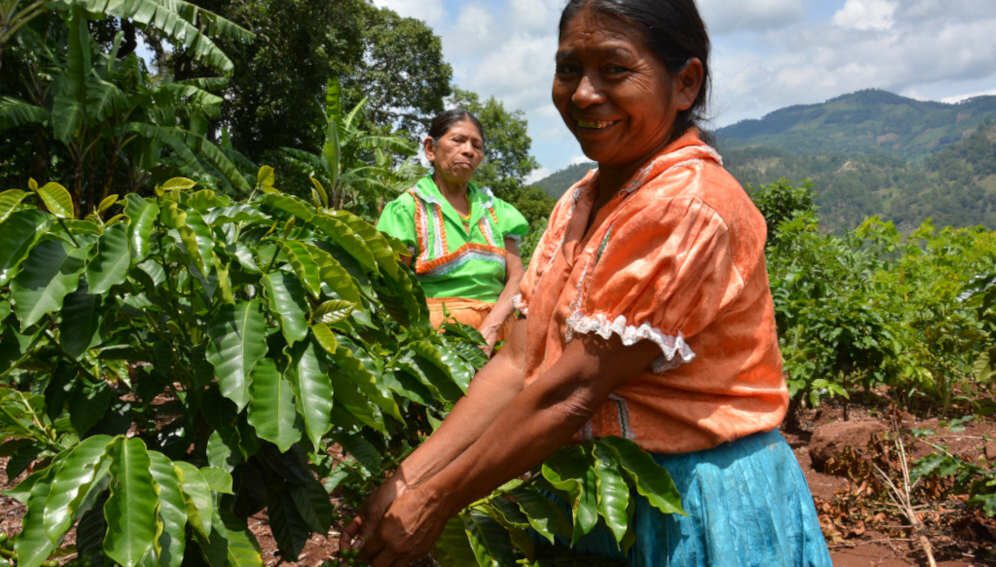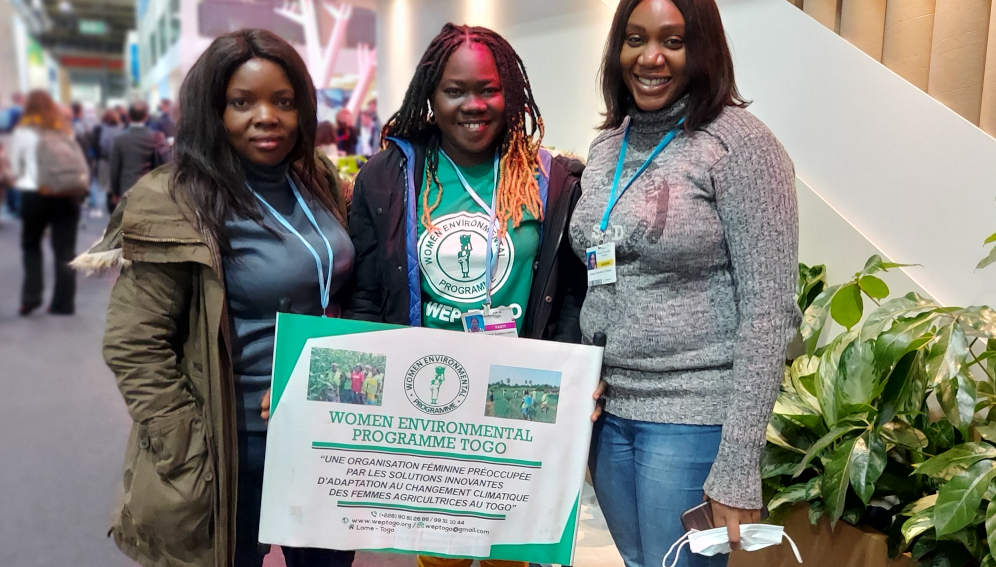13/12/21
Smallholder farmers sow the seeds of COP27

By: Inga Vesper
Send to a friend
The details you provide on this page will not be used to send unsolicited email, and will not be sold to a 3rd party. See privacy policy.
Nigeria offers a window into understanding how farming might fare in a warming world. Bordering the Sahara to the north and the Cameroonian jungles to the south, the country covers nine vegetation zones. Its climate change adaptation challenges include an increased occurrence of droughts as well as flash floods — sometimes both occur within the same state.
Nigeria was among the first countries to establish a national action plan on gender and climate change, as outlined by the United Nations Climate Change Secretariat. And it is not surprising that farmers — especially female farmers — are essential to the plan.
“The majority of Nigerian women from poor areas depend on small-scale farming for their daily provisions,” says Sewuese Asa, from Nigeria’s environment society Angel Support Foundation. “But when it comes to climate change, men have more access to the tools to mitigate it, like fertilisers and financing.”
Asa attended COP26, the UN’s annual climate change conference, in Glasgow last month to advocate for female smallholder farmers and ensure their needs were taken into account in any global emissions reduction deals.

Sewuese Asa (left) with colleagues from the Women Environmental Programme, Essivi Sinmegnon Acakpo-Addra and Abaagu Anne-Marie Torkwase, at COP26. Copyright: Fiona Broom.
Around the world, it is estimated that one-third of all food is produced by smallholder farmers, often for their own consumption. In developing countries, smallholder farming is essential to food provision. But at COP26, many observers worried that these farmers were ignored in the negotiations.
The Global Methane Pledge, formally launched at COP26, aims to reduce methane emissions by 30 per cent from 2020 levels by 2030, through regular meetings and stocktaking. But the pledge, like many related initiatives, highlights complex technical solutions for agricultural emissions.
Now with more than 100 signatories, the pledge commits participants to seek “abatement of agricultural emissions through technology innovation as well as incentives and partnerships with farmers”. According to the Institute for Agriculture and Trade Policy (IATP), a significant share of nitrogen fertilisers — a fossil fuel product — are used to grow feed for livestock, which means their omission from the methane deal overlooks a significant secondary source of emissions.*
Drones, methane digestors
The Agriculture Innovation Mission for Climate (AIM for Climate), officially launched at the summit by the United States and United Arab Emirates, aims to boost spending on research and technologies that could make agriculture more efficient.
However, it too focuses on complex industrial farming that is out of reach of the vast majority of smallholder farmers.
“This approach relies on turning small-scale farms into huge operations managed by machines.”
Tom Wakeford, ETC Group
For example, some of the proposals put forward by AIM for Climate involve the use of drones for crop monitoring and the development of so-called “methane digestors” that would reduce emissions from dairy farms.
To Tom Wakeford, a biologist and member of the ETC Group, which monitors the impact of emerging technologies on agriculture, tech-heavy approaches risk side-lining smallholder farmers and those from poor nations.
“Right now, this approach relies on turning small-scale farms into huge operations managed by machines,” he says.
Jaime Adams, senior adviser for international affairs for the US Department of Agriculture’s chief scientist and a member of the AIM for Climate project, said it recognised “the wide range of participants necessary to achieve its goal”, but underlined that government partners were “the crucial foundation” of the project. She said that non-government partners and philanthropic organisations would be able to participate through specific funding channels and would also be asked to provide knowledge.
There is also growing concern about the trade of agricultural land in newly developed carbon markets. Carbon trading falls under Article 6 of the Paris Agreement, which COP26 sought to strengthen. As part of emissions offsetting, high-emitting and wealthy nations can pay to protect or ‘green’ patches of land in poorer states.
But according to Wakeford, such trading often happens without any involvement from — or even awareness of — the people who farm such land. “It could become a new kind of land grab,” he told SciDev.Net. “Land would be sold to trade on the carbon market so that the US and other high-emission producers can keep drilling for oil.”
The final outcome of the conference left many observers disappointed. Industrial agriculture and animal pasture are high-emission activities that are responsible for a significant amount of biodiversity loss, cause the most human-made methane emissions and are the single biggest reason for deforestation.
Farming will also be disproportionally affected by climate change. Research from NASA’s Goddard Institute for Space Studies found that maize crop yields, for example, could be reduced by 24 per cent if current global warming trends continue.
Climate not-so-smart
Yet, industrial agriculture continues to be largely exempt from emissions reductions requirements, says Timothy Wise, a senior adviser on the future of food at Tufts University and the IATP.*
“Industrial agriculture inputs such as nitrogen fertiliser, derived from fossil fuels, failed to get attention as significant emitters at COP26,” he told SciDev.Net. “Worse still, the use of such inputs is actively promoted in less developed regions such as Sub-Saharan Africa as climate-smart agriculture.”
Nitrogen fertilisers are endorsed as a ‘climate smart’ way to intensify production and therefore reduce the amount of new land being converted for fodder cultivation. The IATP calculated that if Sub-Saharan Africa were to industrialise its farming operations, emissions from fertiliser use on the continent could increase by 800 per cent by 2050.
Another issue that COP26 failed to address is the way rich nations account for farming emissions, according to Patty Fong, programme director for climate, health and wellbeing at Global Alliance for the Future of Food, a group of philanthropic foundations active in farming.
Fong, who attended COP26 as an observer, expressed her disappointment that none of the countries who have submitted Nationally Determined Contributions — documents setting out what each country will do to curb climate change — correctly accounted for emissions from food imports.
“Emissions associated with imported food products can represent a considerable portion of a country’s attributable greenhouse gas emissions,” she said.
As observers headed home from COP26, they were already thinking about next year’s negotiations in Sharm El Sheikh, Egypt.
Fong said she was hoping that COP27 would yield more proposals on how promoting sustainable and healthy diets could bring down emissions.
The World Resources Institute, a research organisation, said the Glasgow summit had shown up important shortfalls in funding adaptation for poorer nations, and hopes for better accountability at COP27.
Yet Nigeria, a test case for how farming will fare under climate change, may turn into a harbinger of solutions. Asa told SciDev.Net that her organisation had — independent of the global initiatives promoted at COP26 — started to think more carefully about how local agricultural practices could be adapted to climate change.
Asa’s Angel Support Foundation is now encouraging smallholder farmers to work with researchers to try out the latest solutions.
“There are some organisations that, for example, give organic pesticides and fertilisers to farmers, and see how some of our local plants can adapt to the changing weather,” she says. “We are trying to sensitise farmers and telling them you can work with some of these researchers or companies that have a strong connection with adaptation to climate change.”
*Correction-30th December
A correction to say “a significant share” instead of 75% of nitrogen fertilisers, was made to provide more accurate information.
Timothy Wise’s affiliation was corrected to ‘a senior adviser on the future of food at Tufts University and the IATP’ to show that the IATP and Tufts are not affiliated as earlier indicated.
This article is part of our Spotlight on ‘The road to climate justice’
This piece was produced by SciDev.Net’s Global desk.


